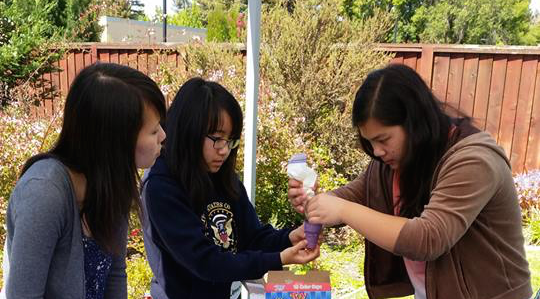Mass media popularizes science
YouTubers find large audience for educational, informative videos

Photo provided by Arun Shriram
Three Foothill High School students perform an experiment at a Science for Youth club meeting. Sci- ence for Youth club’s mission is to encourage and instruct children in various scientific fields.
November 28, 2015
Popular science, or pop science, is currently experiencing a rise in following due to content from accessible sources, such as YouTube, making scientific concepts easy for the general public to digest.
This trend of making informative YouTube videos initially began with videos on cooking and history, but scientific videos have recently become more widespread.
Biology teacher Dr. Kate Schafer’s new course, “The Science of Food,” incorporates aspects of nutrition, chemistry and biology. The course will combine the science behind food with hands-on cooking experiments in the kitchen.
“I think it’s fascinating how many people have approached cooking and food from a scientific perspective,” she said. “People have been cooking for tens of thousands of years, but we’re just now starting to learn about it and understand what’s going on at the molecular level.”
Many entire YouTube channels are geared towards making short videos on a variety of scientific topics, from biology to physics. Some of the most popular channels include AsapSCIENCE, with over 4.2 million subscribers; MinutePhysics, with over 2.9 million subscribers and VSAUCE, with over 9.4 million subscribers.
Sukrit Ganesh (9) is a long-time subscriber of VSAUCE, a channel that teaches its viewers about concepts relating to astronomy, chemistry, physics and quantum mechanics.
“People who love STEM will really enjoy these videos because they can see science being connected to non-STEM topics in weird ways,” he said. “But science is such a prevalent topic in our universe that everyone, whether you’re into STEM or not, should know about it.”
The Science for Youth club has a similar goal of making science accessible, but their programs specifically target children. They teach a wide variety subjects including genetics, psychology and oceanography to students who do not have the opportunity to learn about those subjects at school.
Co-president of the club Arun Sriram (12) particularly enjoys seeing the change in students’ attitudes towards science after the club’s presentations.
“It’s really fun to see the joy and the light that a lot of students have during our presentations when they learn about a lot of really cool things that aren’t necessarily taught in school,” he said.
Senior Natalie Simonian, the other co-president of the Science for Youth club, discussed her opinion on the benefits of the spread of accessible science.
“The world that we live in is overwhelmingly transforming into a science driven world,” she said. “It’s a critical subject that everyone needs to be aware of. Even in small parts, people need to have some knowledge. It’s requisite.”
The club is currently working on expanding their audience from students at libraries to an elementary school in San Jose.
This piece was originally published in the pages of The Winged Post on November 20, 2015.


















![“[Building nerf blasters] became this outlet of creativity for me that hasn't been matched by anything else. The process [of] making a build complete to your desire is such a painstakingly difficult process, but I've had to learn from [the skills needed from] soldering to proper painting. There's so many different options for everything, if you think about it, it exists. The best part is [that] if it doesn't exist, you can build it yourself," Ishaan Parate said.](https://harkeraquila.com/wp-content/uploads/2022/08/DSC_8149-900x604.jpg)




![“When I came into high school, I was ready to be a follower. But DECA was a game changer for me. It helped me overcome my fear of public speaking, and it's played such a major role in who I've become today. To be able to successfully lead a chapter of 150 students, an officer team and be one of the upperclassmen I once really admired is something I'm [really] proud of,” Anvitha Tummala ('21) said.](https://harkeraquila.com/wp-content/uploads/2021/07/Screen-Shot-2021-07-25-at-9.50.05-AM-900x594.png)







![“I think getting up in the morning and having a sense of purpose [is exciting]. I think without a certain amount of drive, life is kind of obsolete and mundane, and I think having that every single day is what makes each day unique and kind of makes life exciting,” Neymika Jain (12) said.](https://harkeraquila.com/wp-content/uploads/2017/06/Screen-Shot-2017-06-03-at-4.54.16-PM.png)








![“My slogan is ‘slow feet, don’t eat, and I’m hungry.’ You need to run fast to get where you are–you aren't going to get those championships if you aren't fast,” Angel Cervantes (12) said. “I want to do well in school on my tests and in track and win championships for my team. I live by that, [and] I can do that anywhere: in the classroom or on the field.”](https://harkeraquila.com/wp-content/uploads/2018/06/DSC5146-900x601.jpg)
![“[Volleyball has] taught me how to fall correctly, and another thing it taught is that you don’t have to be the best at something to be good at it. If you just hit the ball in a smart way, then it still scores points and you’re good at it. You could be a background player and still make a much bigger impact on the team than you would think,” Anya Gert (’20) said.](https://harkeraquila.com/wp-content/uploads/2020/06/AnnaGert_JinTuan_HoHPhotoEdited-600x900.jpeg)

![“I'm not nearly there yet, but [my confidence has] definitely been getting better since I was pretty shy and timid coming into Harker my freshman year. I know that there's a lot of people that are really confident in what they do, and I really admire them. Everyone's so driven and that has really pushed me to kind of try to find my own place in high school and be more confident,” Alyssa Huang (’20) said.](https://harkeraquila.com/wp-content/uploads/2020/06/AlyssaHuang_EmilyChen_HoHPhoto-900x749.jpeg)









